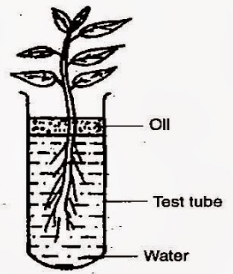Identify and name the following processes/terms from the statements given below:
(iv)The loss of water from InJured parts of a plant.
Bleeding
Identify and name the following processes/terms from the statements given below:
(iv)The loss of water from InJured parts of a plant.
Bleeding
Name the following:
The waxy layer on the epidermis of the leaf meant to reduce transpiration.
Give the biological/technical terms for the following:
Permanently open structures seen on the bark of an old woody stem.
Given below are five groups of terms. In each group, arrange and rewrite the terms in the correct order so as to be in a logical sequence. For example,
Question: Implantation, Parturition, Ovulation, Gestation, Fertilisation.
Answer: Ovulation, Fertilisation. Implantation. Gestation, Parturition.
Spongy ceiJs, Upper epidermis, Stoma, Palisade tissue, Sub-stomatal space
Mention the exact location of the following structures:
iii. Lenticels
An apparatus as shown below was set up to investigate a physiological process in plants. The setup was kept in sunlight for two hours. Droplets of water were then seen inside the bell jar. Answer the questions that follow:
i. Name the process being studied.
ii. Explain the process named above in ii.
iii. Why was the pot covered with a plastic sheet?
iv. Suggest a suitable control for this experiment.
v. Mention two ways in which this process is beneficial to plants.
vi. List three adaptations in plants to reduce the above mentioned process.
Study the diagram given below and answer the following questions:
(i) Name the process being studied in the above experiment.
(ii) Explain the process mentioned in (i) above.
(iii) Why is oil placed over water?
(iv)What do we observe with regard to the level of water when this setup is placed in
(1) bright sunlight, (2) humid conditions and (3) on a windy day?
(v) Mention any three adaptations in plants to overcome the process mentioned in (ii)
Mention the effects of two individuals in a street fight on the following organs by the autonomous nervous system (one has been done for you).
| Organ | Sympathetic nervous system | Para-sympathetic nervous system |
| eg Lungs | Dilates bronchi and brochioles | contricts bronchi and bronchioles
|
| 1) Heart 2 Pupils of the eye 3 . Salivary |
(ii) List four major activities of the Red Cross.
Name the following:
(ii) A plant with sunken stomata.
Mock Test Series